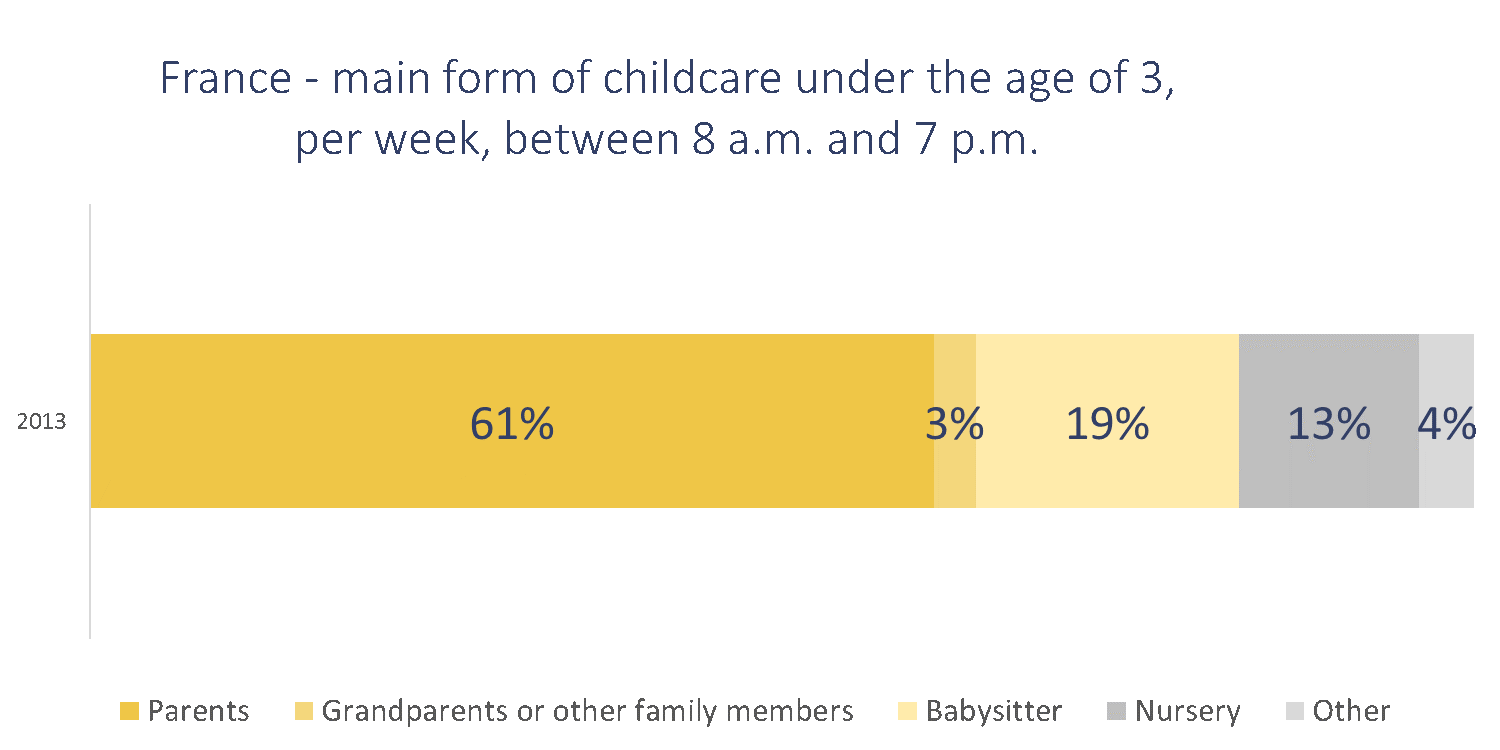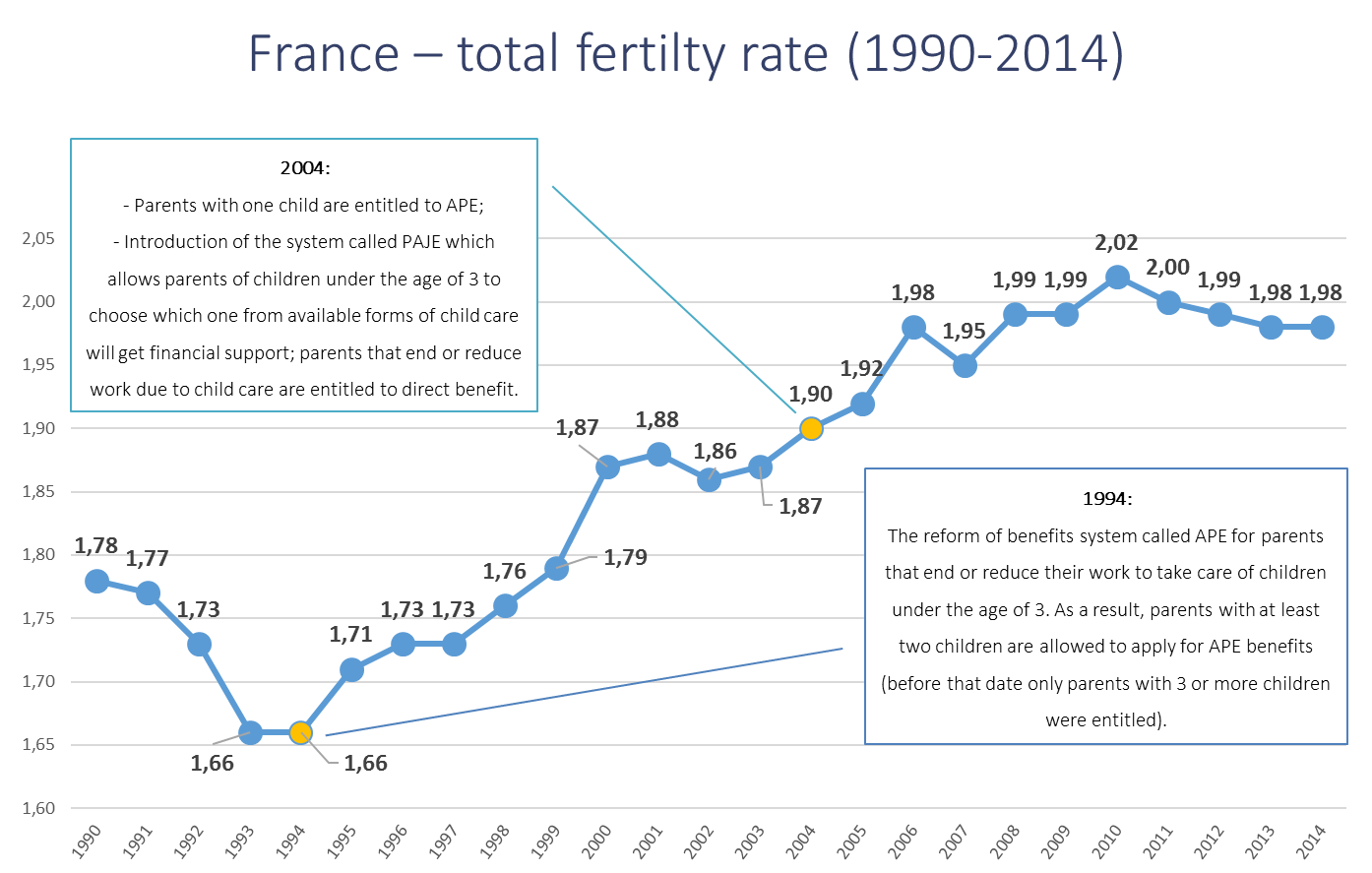
The purpose of this document is to present the main principles applied by the EU in its demographic policy and to confront them with actual expectations of European women and families. The first two parts of this paper describe the actions undertaken by the EU in order to fight the demographic crisis, and its gender equality policy. Consecutive parts will confront these main considerations with statistical data showing women’s aspirations as regards maternity and gainful employment as well as with scientific research on the consequences of nursery and preschool enrolment on children’s development.
1. EU Competence in the Field of Family Relations
According to Article 9 of the Charter of Fundamental Rights of the EU, Member States have the exclusive competence to regulate the issues concerning marriage and family law6. As it is stressed by different publications, substantive family law remains outside of the EU competence7. For these reasons, in order to interfere in the family relations connected with, e.g., the division of tasks between spouses, the EU is usually using its competence to fight against discrimination and social inequalities. It has to be stressed nonetheless that social policy issues are a competence shared between the EU and Member States (Articles 4 and 7 TEU)2. As a consequence, the EU, while undertaking any action in this area, has to follow the principle of subsidiarity. It should be also emphasised that the principle of subsidiarity (art. 5 TEU), which should be included all EU policies, refers to family, which is as basic social unit.
At the same time, even though many documents published by EU bodies (such as recommendations and strategies of the EC) are not binding, in practice EU institutions act in a way that soft law through indirect effect rule can be taken into account while interpreting domestic law3 and can be also used in order to clarify provisions of the directives.
2. EU actions improve demographic situation
The main principles of the EU demographic policy were presented for the first time in the Commission Communication “The demographic future of Europe” dated 2006[1]. According to this document, the demographic situation in Europe depends on three major elements: fertility, average life expectancy and issues connected with the influx of immigrants[2]. Authors of that paper note that lower total fertility rate (hereinafter: TFR) may have serious consequences for the European economy, which may be even stronger when connected with longer average life expectancy. A growing average age of the population, delaying motherhood and an ever increasing number of the retired may lead to a collapse of social insurance schemes, lower employment and production[3].
In order to improve the demographic situation in Europe and to mitigate the economic consequences of the demographic crisis, the European Commission proposed in 2006 activities in 5 areas of EU policy. They aim at increasing fertility, employment indicators, production efficiency, reception of immigrants and their assimilation as well as at improving and stabilizing public finances[4]. For the purpose of this document the first two activities seem to be the most important. The main solution to the problem of the low childbirth rate and late motherhood proposed by the authors of the Communication is the creation of more institutionalised state-owned childcare facilities that will allow women to return work or their professional activation[5].
The 2009 Communication on the ageing of the population is written in the same vein[6]. It recalls the five major areas of activity of the EU enumerated above that are to help come out of the demographic crisis[7], focusing on equality issues. Again the work done by women while staying at home taking care of their children is perceived negatively and the solutions suggested by the Commission do not aim at increasing childbirth but the number of people with gainful employment[8].
Since the publication of the Communication in 2006, every two years demographic forums are organised within EU structures that debate on the condition of demography in Europe and on remedial measures to help fight the crisis[9]. Every session of the European Demography Forum is summarized in a report published by the Commission. The last report dates back to 2013 and in principle repeats the demands of the 2006 Communication.[10] Also this report suggests as a solution to demographic problems to increase employment rates (also through professional activation of women), actions in favour of gender equality and investments in nursery and preschool education and childcare[11].
The above documents show that it is impossible to analyse the EU demographic policy without the context of its equality and antidiscrimination policies. Although, as shown in the introduction, the European Union is not competent in the field of family law, it is using gender equality policy to shape family relations.
The whole of EU documents on equal rights of women shows that the main source of inequality between women and men is the fact that women dedicate more time than men to childcare. Also childcare activity carried out by parents is not seen by EU institutions as work. Thus, according to the authors of EU documents, women who spend time caring for their children are deprived of professional fulfilment and this means that they do not have the possibility of self-fulfilment. Motherhood is seen in these documents in a rather negative manner and the strategies adopted by the European Union aim at minimizing its “negative effects” by transferring the burden of childcare to state institutions.
As regards the implementation of gender equality policy, the gender equality strategies of the European Commission are important. The currently binding strategy is the Strategy for Equality between Women and Men 2010–2015 adopted by the European Commission. The document mainly calls for the widest possible professional activation of women while at the same time it looks negatively at motherhood. The authors of the strategy stress an ever stronger presence of women on the labour market and this is positive but inequalities still persist whereas “parenthood keeps female employment rate down”[12], thus leading to economic inequalities and “segregation” on the labour market[13]. Even though the document calls for “a more extensive and efficient use of women’s potential and talent”[14], at the same time it encourages to employ women in the sectors in which currently mainly men work and it is reluctant towards the selection of professions preferred by women themselves and is unfavourable towards them choosing part-time work[15].
Motherhood is presented as an obstacle to professional activation of women and caring for children while staying at home to do so are considered as factors hampering employment thus leading to gender inequality. In order to improve the situation of women the European Commission calls for measures to facilitate “work-life balance” by implementing a policy based on the availability of affordable high-quality care[16].
Currently the European Commission is working on a document “Strategic engagement for gender equality 2016–2019”[17], which is to replace the above Strategy for equality between women and men 2010–2015. This document, in its current shape, is a follow-up of the actions that have been so far taken by the EU as regards gender equality. Again the document is based on the conviction that women’s equality is best illustrated by their employment rate. It shows, among others, that women still “generate a much lower proportion of income” than men[18] as they more often dedicate themselves to care and parenting. The document also criticizes the fact that women are much more likely to work part-time than men and this leads to an earnings gap between women and men[19]. Because of that, one of the EU objectives to reach gender equality is to increase the women’s overall paid working hours.
Yet another type of documents presenting equality issues in a similar way are EU general development strategies: Lisbon Strategy and the currently binding Strategy “Europe 2020”[20].
The first document called for the EU to achieve the employment rate at the level of 60%[21]. The EU Member States were to achieve this rate by creating the most extensive network of childcare facilities. Right now the key document defining EU objectives for consecutive years is the Strategy “Europe 2020”, which calls for achieving the employment rate of women and men of 75% and equal pay by preventing women from working part-time[22]. Also this Strategy says that such gender equality policy means that Member States have to pressure to spend more money on public childcare facilities[23].
The document that defines detailed guidelines for the states to act in favour of “professional activation” of women by implementing comprehensive institutional collective childcare are the Barcelona objectives set by the European Council in 2002. According to these objectives by 2010 even 90% of children from 3 years and older, and 33% of children under 3 years of age should be provided childcare[24]. As we can read in the Commission report on the implementation of Barcelona objectives these rates were not achieved. It was stressed that “the availability of high quality, affordable childcare facilities for young children from birth to compulsory school age is a priority for the European Union”[25]. Interestingly enough the report keeps repeating without any objections the thesis saying that collective childcare has a positive influence on their social integration and personal development[26]. As it will be later presented in this document a lot of research shows that when children under 3 years of age or older spend too much time in pre-schools and nurseries this has a negative impact on their psychological and physical growth.
As it has been shown the policy of the European Union is based on actions aiming at increasing the number of women working full-time. Thus the European Union calls for the creation of as many childcare institutions for young children as possible. Is this policy effective and does it correspond to real parents’ needs?
Data presented by numerous reports (also those prepared by EU institutions[27]) show that despite the gender equality policy that dominates the EU and some European states, and which promotes an extensive professional activation of women, the majority of mothers want to spend more time with their young children. The research conducted in 2002 in 19 European states shows[28] that women who are mothers of young children at pre-school age usually prefer part-time work or entirely dedicate themselves to care and parenting. This tendency remains also once the youngest child has reached the pre-school age. This is confirmed by another research conducted in 2011 by the organisation Mouvement Mondial des Mères-Europe[29] which shows that only 11% of mothers in Europe want to work full-time. Almost 2.5 more women would like to dedicate themselves to parenting and working at home (26%). The majority of women (63%) want to have the possibility to have flexible working time in order to adapt to family responsibilities stemming from the necessity to take care of children.
According to statistical data, in many European states, especially there where the demographic situation has improved over the last dozen or so years, parents (especially mothers) more often work flexible hours (e.g. Great Britain, France or Ireland)[30]. Therefore there is a positive correlation between the possibility for the parents to work flexible hours and the total fertility rate. Poland is an example of a state where the rate of people working part-time is low. In 2013 in Poland only 11.1% women worked part-time (TFR 1.29), in Hungary only 9.3% (TFR 1.35), whereas in France 30.6% (TFR 1.99), in Ireland 35.6% (TFR 1.98), and in the UK even 42.7% (TFR 1.83)[31].
Table 1. Women working part-time and the total fertility rate (TFR)
|
|
Women working part-time (%) |
TFR (2014) |
|
Great Britain |
42.70% |
1.83 |
|
Sweden |
38.80% |
1.89 |
|
EU average |
32.90% |
1.55 (2013) |
|
France |
30.60% |
1.98 |
|
Estonia |
14.20% |
1.52 |
|
Poland |
11.10% |
1.29 |
|
Czech Rep. |
11% |
1.53 |
|
Hungary |
9.30% |
1.41 |
The above data show that the possibility of flexible working hours or part-time employment has a positive influence on the fertility rate in a given state. It cannot be ignored that these solutions are preferred by a majority of mothers in Europe. The demographic and gender equality measures proposed by the European Union aiming at increasing the number of women working full-time shall be assessed as negative. They intensify negative stereotypes of women who decide to give up gainful employment fully or in part to dedicate themselves to parenting and treat them as a burden for the European economy. They also ignore numerous research clearly showing that employment of women, especially when the labour market is not adapted to their needs connected with motherhood, has a negative correlation with fertility[32].
The EU ignores the fact that parenting and childcare exercised by women (or men) is very good for the economy and contributes to the increase of GDP in average by 40% and this constitutes a discrimination. It is not true that people who give up gainful employment temporarily or permanently constitute a burden for the European economy, on the contrary. Moreover such people more often decide to have more children and in consequence have a positive impact on demography rates in a given state. Stigmatizing language used for women who decide to choose such a way of life and ignoring their needs as regards social security, appreciation of household work or a lack of the possibility to choose the childcare model not only do not contribute to the fight against discrimination but increase it. Even though as the above research shows a big majority of women choose motherhood and parenting work at home knowingly they are still perceived in a negative way, as “parasites”, having no ambition or unaware of their rights. A real gender equality policy should fight against such prejudice and strive to value the parenting activity of women (and men) just as much as the gainful employment is valued.
5. Development of Children and the Collective Childcare
The second most important principle of the demographic policy conducted by the European Union is the creation of an extensive network of institutions offering collective childcare of young children. Institutional childcare is to “relieve” women of the necessity to take care of their young children (even though as already shown a majority of women prefer to take care of their own children themselves and to stop or to limit gainful employment) and also to impact the development of children in a positive way, and in consequence to contribute to the increase of fertility rates in Europe.
The example of such countries as Poland or Portugal, where family policy is based on the creation of many nurseries and pre-schools, it is difficult to consider the adoption of such solutions as pertinent. Poland and Portugal are both the states where children stay the longest in nurseries within the whole European Union. At the same time these are countries where parents do not have the possibility to work flexible hours or part-time. In Portugal which is struggling with a serious demographic crisis, children spend in average 39.5 hours per week in nurseries whereas the EU average amounts to 26.4 hours per week[33]. A similar situation occurs in Poland as well – Poland is among the countries with the lowest fertility rate and a family policy which has been based on the creation of an extensive network of institutionalised collective childcare. Children attending nurseries in Poland spend there in average more than 39 hours per week (39.1).
The policy based on the creation of many facilities offering institutionalised collective and “full-time” childcare does not bring any positive results as regards the increase of the fertility rate in different states. Moreover this policy keeps ignoring scientific research which has been proving that children who are sent to such facilities too soon (below 3 years of age) or spend there too much time have later serious development problems.
First of all institutional care means that breastfeeding is significantly limited or stopped altogether and products replacing mother’s milk are introduced. Sometimes it is the mother’s decision to stop breastfeeding but many a time it happens against their will – they lose the milk because of the separation from the child and of the stress connected with it. Meanwhile the World Health Organization indicates the necessity of exclusive breastfeeding during the first 6 months and adds that after 12 months of age breastfeeding shall be continued as long as desired by the mother and the child[34]. Sending children to a nursery weakens the bond with the parents, contributes to emotional and developmental problems. It also has a negative influence on the parents who are more prone to depression.
Similar objections can be raised as regards pre-school childcare. Pre-school may constitute an important step in the child’s development as it allows children to develop their social skills, however in some cases it may be harmful for the child. A clearly positive influence of pre-school is noted in the case of children from disadvantaged homes or broken families – it allows to close the achievement disparity and can increase their intellectual potential[35]. Pre-school also contributes to a certain extent to boost children’s math and reading skills[36].
Researchers stress that long duration exposure of children to a preschool, especially when a child is enrolled at a very early stage of his/her life, can be detrimental to the child’s development. Children spending longer hours in a preschool can exhibit elevated levels of stress or anxiety. An extensive research conducted in California covering more than 14,000 children has shown that children spending longer hours within a week in a pre-school have negative social-developmental outcomes, less effective impulse control or elevated levels of aggression regardless of children’s age, race or background[37]. Researchers point out that time spent in a preschool is of key importance for children’s behaviour[38]. They stress that – “children spending longer hours or more months in centre care each year exhibit greater problem behaviours, including elevated levels of aggression and less effective impulse control”[39].
Similar conclusions can be drawn from a recent study published by Dutch researchers. Data presented by them show that children who spend too much time in preschool – especially if they attend a facility offering low-quality care – suffer more often than their peers from hormonal imbalance as regards cortisol secretion[40], commonly referred to as the “stress hormone”. Under normal conditions the level of cortisol in the human body is at its peak in the early morning and is gradually declining. Children show this correct rhythm of hormone secretion while at home, whereas children spending most of the day in a preschool show clear disorders[41]. It has to be pointed out that chronic stress leads to health and developmental problems which in return weaken the body, cause aggressive behaviour or, in the future, mental disorders such as neurosis[42].
In the light of the above EU recommendations claiming the creation of an extensive network of collective childcare shall be treated critically as they ignore research showing that long-term or too early enrolment of a child in such a facility may have a negative impact on the child’s development causing antisocial behaviour, poor concentration levels or self-control.
A unilateral policy based exclusively on collective childcare facilities does not contribute to improving the situation of a majority of mothers and their children. It deprives them of the right to decide on how to take care of their own children and stigmatizes parents who choose to work at home caring for their child. Moreover it ignores the fact that at such a young age there are significant developmental differences that parents are best placed to define. Opinion poll conducted in Poland (where collective childcare model prevails) in 2011 shows that even 85% of Polish mothers with children aged from 4–36 months would most likely entrust the care of their child to a babysitter from among their closest relatives or friends and more than half of the respondents (52%) would not like to send their children to a nursery at all[43].
It is not the state but the family that can assess best whether a child is ready to be sent to a collective childcare facility. Thus rates showing that 90% of children should attend preschool and 33% should be enrolled in a nursery are not good. The current family policy of the European Union deprives mothers and fathers of empowerment and the possibility of choice. Such states like France show that a free choice of childcare is a key factor allowing to increase the fertility rate. The French childcare law offers a vast array of ways allowing to strike the right work-life balance, among others by promoting flexible employment, state accredited and co-financed babysitters or finally family benefits. The majority of young children’s parents in France benefit from the help offered by the state as regards childcare at home[44].
6. Family policy measures in EU member states
Comparison of family policy measures in various European countries shows that family policies based on parents’ freedom of choice correlate with higher fertility rates than policies based solely on collective institutional care over children.
Family policy of France may serve as an example of a system based on the freedom of choice. French system of state support for childcare (APE and PAJE) leaves decision concerning the form of childcare to parents. Parents can decide whether state support for childcare will be used by public nurseries, accredited babysitters and childcare conducted directly by parent, grandparents or other family members.
Statistical data shows that the overwhelming majority of French parents either choose to perform childcare directly, perform it with the assistance of grandparents or other family members, or use the services of nannies or other family members. Solely 13% of parents decide to use public nurseries as the main form of childcare during the working days[45].

Introduction of family policy measures allowing parents of children under the age of 3 to choose which one of the available forms of childcare they use correlated with the shift in trends of total fertility rate among French woman both when direct benefit was introduced for every second child under the age of 3, which took place in 1994, and when it was introduced for every child under the age of 3, which took place in 2004. In both cases, introduction of the measures coincided with the beginning of the rise of French TFR, which is currently second highest in the EU.

Analysis of Estonian family policy also proves that introduction of simple direct measures, which leave the most important decisions concerning rearing of a children to parents[46], correlated with the increase in total fertility rates. Similar conclusions follow analysis of family policies realised in Czech Republic and Finland, both entirely based on parental freedom of choice of the form of childcare over children under 3 years of age. On the other hand, the analysed countries which significantly increased funding of collective care facilities after 2000, e.g. Portugal and Poland, did not experience significant rise in TFR[47].
The analysis proves that recommendations concerning family policy issued by the European Commission and the European Council need a thourough revision, which should be based on comprehensive evaluation of effectiveness of policies introduced by the member states, as well as on the analysis of parents preferences. The documents should be also analysed with respect to the fundamental principle of subsidiarity (Article 5 of the Treaty on European Union).
While most of the EU documents relating to family policy issues recommend one-sided support for the collective care facilities, the conducted analysis proves that introduction of policies based on the freedom of choice concerning childcare may better reflect parents’ preferences. Moreover, a number of examples prove that introduction of such policies may correlate with commencement of the increase in total fertility rates.
It also turns out that, while a number of EU demographic documents is aimed to realise the principle of equality, it is very often understood fragmentary and does not reflect all important characteristics which should be protected from discrimination. In particular, EU policy recommendations should acknowledge the social and economic value of duties concerning parenthood and motherhood. In particular, the view of unpaid childcare as “economic inactivity” should be abandoned. With respect to the principle of subsidiarity, the Commission and the Council are advised to acknowledge that part-time work and flexible working conditions facilitate combination of paid work and unpaid childcare work.
[1] Commission Communication 12.10.2006, The demographic future of Europe – from challenge to opportunity, COM (2006) 571 final, http://eur-lex.europa.eu/legal-content/PL/TXT/PDF/?uri=CELEX:52006DC0571&from=EN, access 18 September 2015.
[2] Ibid., p. 3–4.
[3] Ibid., p. 6–7.
[4] Ibid., p. 14.
[5] Ibid., p. 8–9.
[6] Communication from the Commission to the European Parliament, the Council, the European Economic and Social Committee and the Committee of the Regions 29.4.2009, Dealing with the impact of an ageing population in the EU (2009 Ageing Report) KOM(2009) 180 final, http://eur-lex.europa.eu/legal-content/PL/TXT/PDF/?uri=CELEX:52009DC0180&from=PL, access 18 September 2015.
[7] Ibid., p. 8.
[8] Ibid.
[9] Commission Communication, The demographic future of Europe, op. cit. p. 8–9.
[10] Employment, Social Affairs & Inclusion, The Fourth Demography Forum, http://ec.europa.eu/social/BlobServlet?docId=10228&langId=en, p. 4, access 18 September 2015.
[11] Ibid., p. 5, 9 and 10.
[12] Communication from the Commission to the European Parliament, the Council, the European Economic and Social Committee and the Committee of the Regions 29.4.2009, Strategy for …, op.cit., Introduction.
[13] Ibid., subpara. 2: Equal pay for equal work.
[14] Ibid.
[15] Ibid.
[16] Ibid, subpara. 1.1.: Equal economic independence.
[17] Working document of the European Commission „Strategic engagement for gender equality 2016–2019.
[18] Ibid., p. 4.
[19] Ibid., p. 5.
[20] Commission Communication, Europe 2020…, op. cit.
[21] A. Budzyńska, M. Duszczyk, M. Gancarz, E. Gieroczyńska, M. Jatczak, K. Wójcik, Strategia Lizbońska – droga do sukcesu zjednoczonej Europy, Gdańsk 2002, p. 12.
[22] Commission Communication, Europe 2020, op. cit.
[23] Ibid., p. 21.
[24] Barcelona European Council, Presidency Conclusions, 15 and 16 March 2002, SN 100/1/02 REV 1, s. 12; for more: Report from the Commission to the European Parliament, the Council, the European Economic and Social Committee and the Committee of the Regions, Barcelona objectives. The development of childcare facilities for young children in Europe with a view to sustainable and inclusive growth, COM(2013) 322 final, p. 1.
[25] Ibid., p. 3.
[26] Ibid., p. 4.
[27] See European Commission, New Skills and Jobs in Europe, France 2012, http://ec.europa.eu/research/social-sciences/pdf/new-skils-and-jobs-in-europe_en.pdf , p. 19–20, access 7 August 2015.
[28] Ibid., p. 19–20.
[29] Survey of Mothers in Europe 2011 results, http://www.mmmeurope.org/ficdoc/2011-MMM_BROCHURE_What_Matters_Mothers_Europe.pdf, access on 9 July 2015. This research was conducted among 11 187 mothers from France, Spain, Germany, Hungary, Great Britain, Italy, the Netherlands, Sweden, Slovakia, Finland; among them 52% was aged 26-40, 36% between 41–55 years old. The research was conducted based on snowball sampling.
[30] Najwyższa Izba Kontroli /Supreme Audit Office/, Koordynacja polityki… /Coordination of the Policy../, op. cit., p. 55.
[31] Data: Eurostat 2013. The highest part-time employment rate was achieved in the Netherlands and amounted to 77.2% (TFR 1.68).
[32] A. Matysiak, D. Vignoli, Diverse Effects of Women’s Employment on Fertility: Insights From Italy and Poland, “European Journal of Population” no. 29 (2013), p. 275.
[33] Eurydice and Eurostat. Report, Key Data on Early Childhood Education and Care in Europe, Brussels 2014, p. 64.
[34] World Health Organization, Infant and young child feeding : model chapter for textbooks for medical students and allied health professionals, http://apps.who.int/iris/bitstream/10665/44117/1/9789241597494_eng.pdf?ua=1&ua=1, p. 5, access 31 March 2016.
[35] S. Loeb, M. Bridges, D. Bassok, B. Fuller, R. Rumberger, How much is too much? The influence of preschool centers on children’s social and cognitive development NBER Working Paper No. 1181226, December 2005, http://www.nber.org/papers/w11812.pdf, p. 1 – 3, access 13 July 2015.
[36] Ibid., p. 4.
[37] S. Loeb (and others), How much…, op. cit., p. 4, p. 11.
[38] Ibid., p. 13–16.
[39] Ibid., p. 4.
[40] M. Groeneveld, M.H. van IJzendoorn, Stress, cortisol and well-being of caregivers and children in homebased child care: a case for differential susceptibility, [in:] Child Care Health and Development, December 2010, p. 78.
[41] M.-C. Geoffroy, S.M. Côté, S. Parent, Daycare attendance, stress, and mental health, “Canadian journal of psychiatry” 2006; 51(9), p. 614.
[42] Ibid., p. 608, 613.
[43] Study Attitudes of young children’s mothers as regards young children development and childcare conducted by MillwardBrown SMG/KRC at the request of Nutricia on a sample of 734 mothers of children aged 4–36 months. The study was conducted between 30 May and 24 June 2011.
[44] F. von Lennep (ed.), Mode de garde et d’accueil des jeunes enfants en 2013, “ÉTUDES et RÉSULTATS“ 2014, n. 896.
[45] S. Villaume, É. Legendre, Modes de garde et d’accueil des jeunes enfants en 2013, “Direction de la recherche, des études, de l’évaluation et des statistiques. Études et résultats”, no 896, October 2014, p. 4.
[46] Statistics Estonia, Statistical Database, http://pub.stat.ee/, access 30 July 2016; J. Kore, Social Policy development in Estonia in Liberal Political and Economical Circumstances, http://www.fafooestforum.no/arkiv/Estland/juri_kore.pdf, access 01 August 2016; Republic of Estonia Social Insurance Board, Parental benefit, http://www.sotsiaalkindlustusamet.ee/parental-benefit/, access 29 July 2016; Raport Instytutu Ordo Iuris /Ordo Iuris Institute’s Report/, Jakiej polityki rodzinnej potrzebuje Polska? /What Kind of Family Policy does Poland Need?/, ed. T. Zych, K. Dobrowolska, O. Szczypiński, Warsaw 2015, p. 67.
[47] Cf. e.g. ibid., p. 117, p. 121-131 and literature mentioned.

Family and marriage
On the 27th of May 2020, two representatives of the European Commission – Mr Joost Korte, Director-General of the Directorate General for Employment, Social Affairs and Inclusion and Marc Lemaître, Director-General of the Directorate General for Region

Family and marriage
“Gender” is a relatively new term, the origins of which lie in some psychological and sociological theories. It has its special place in the second and third wave of feminist concepts. It should be emphasised that this term carries a strong ideological charge.

Family and marriage
1. Introductory remarks